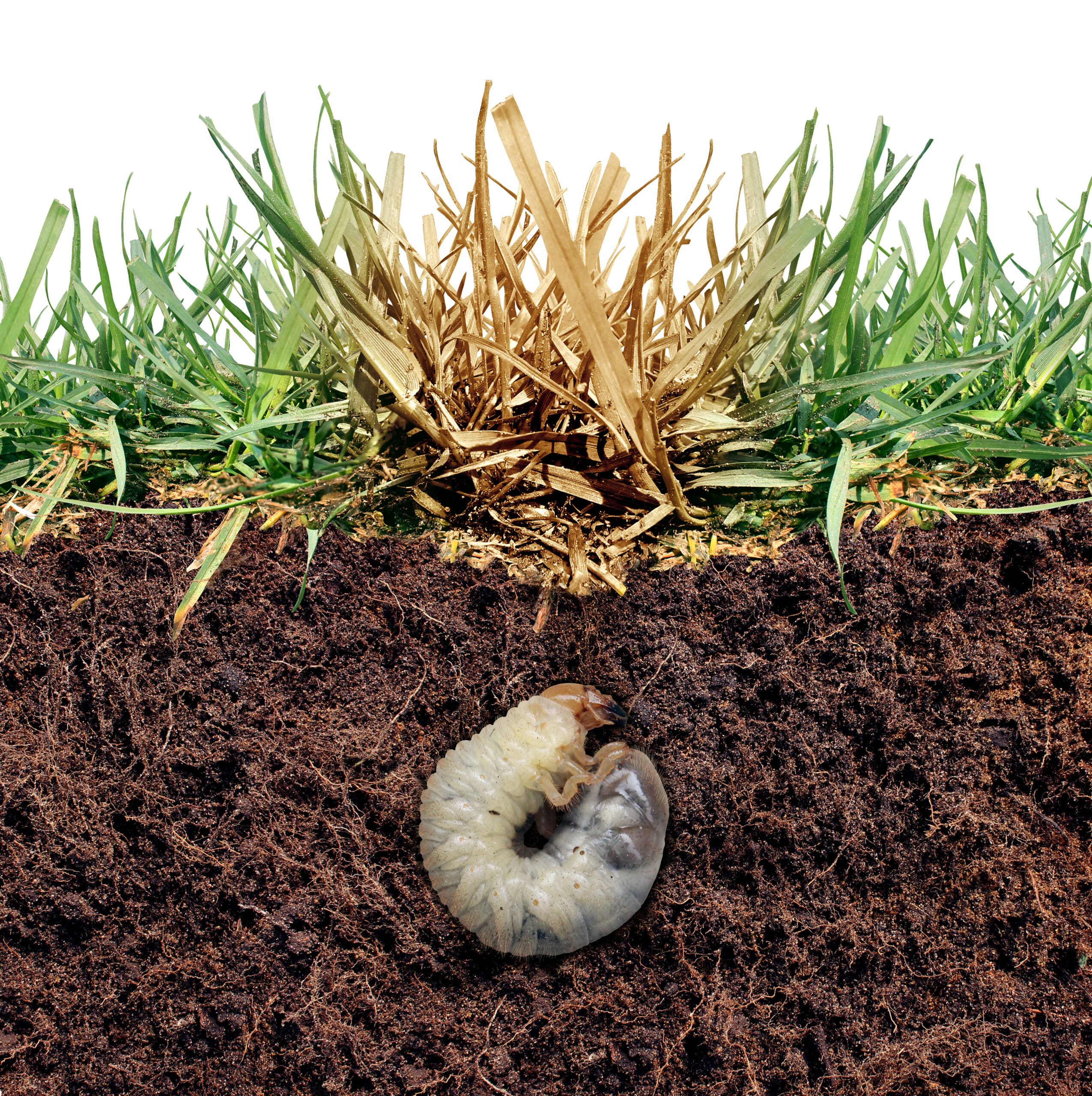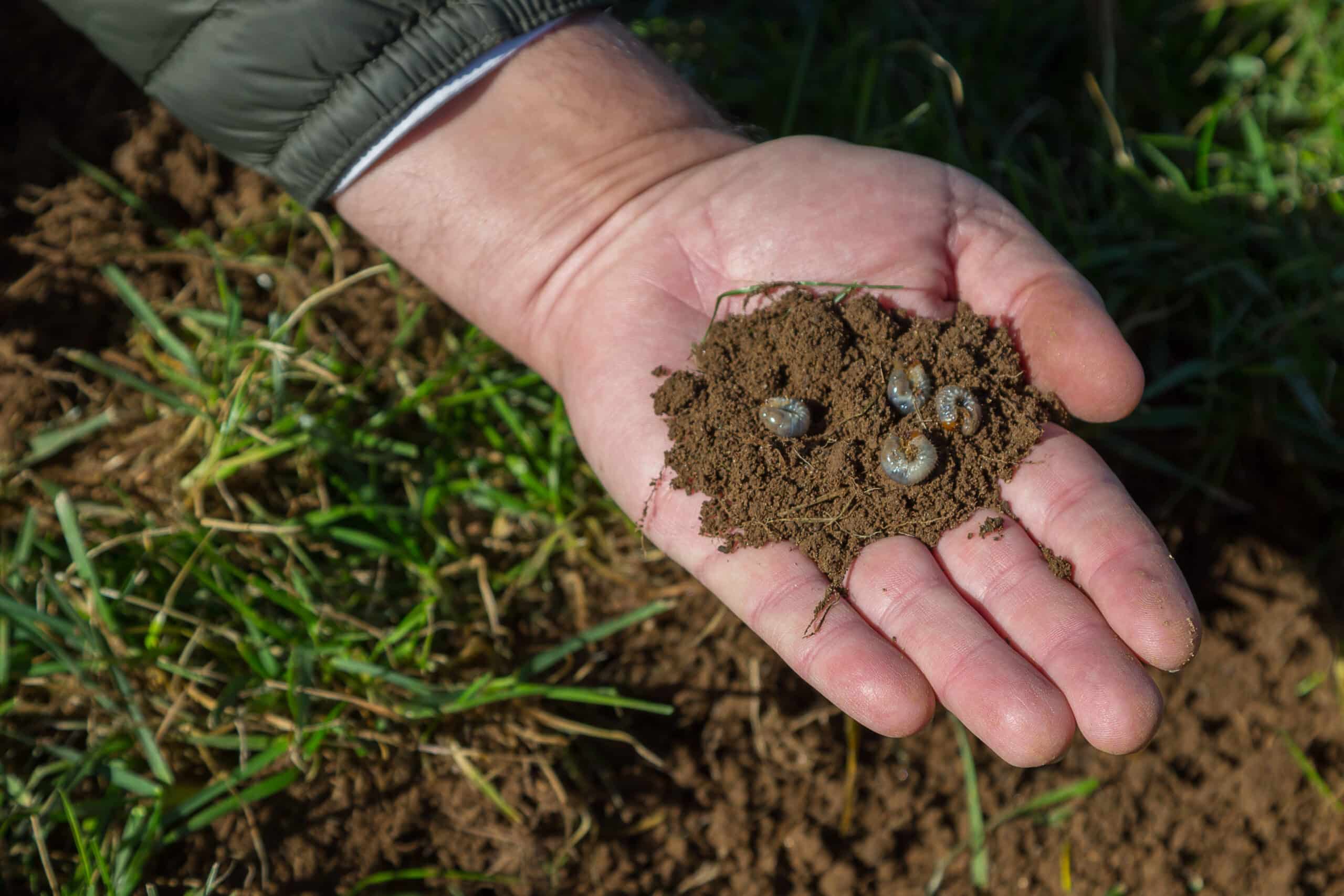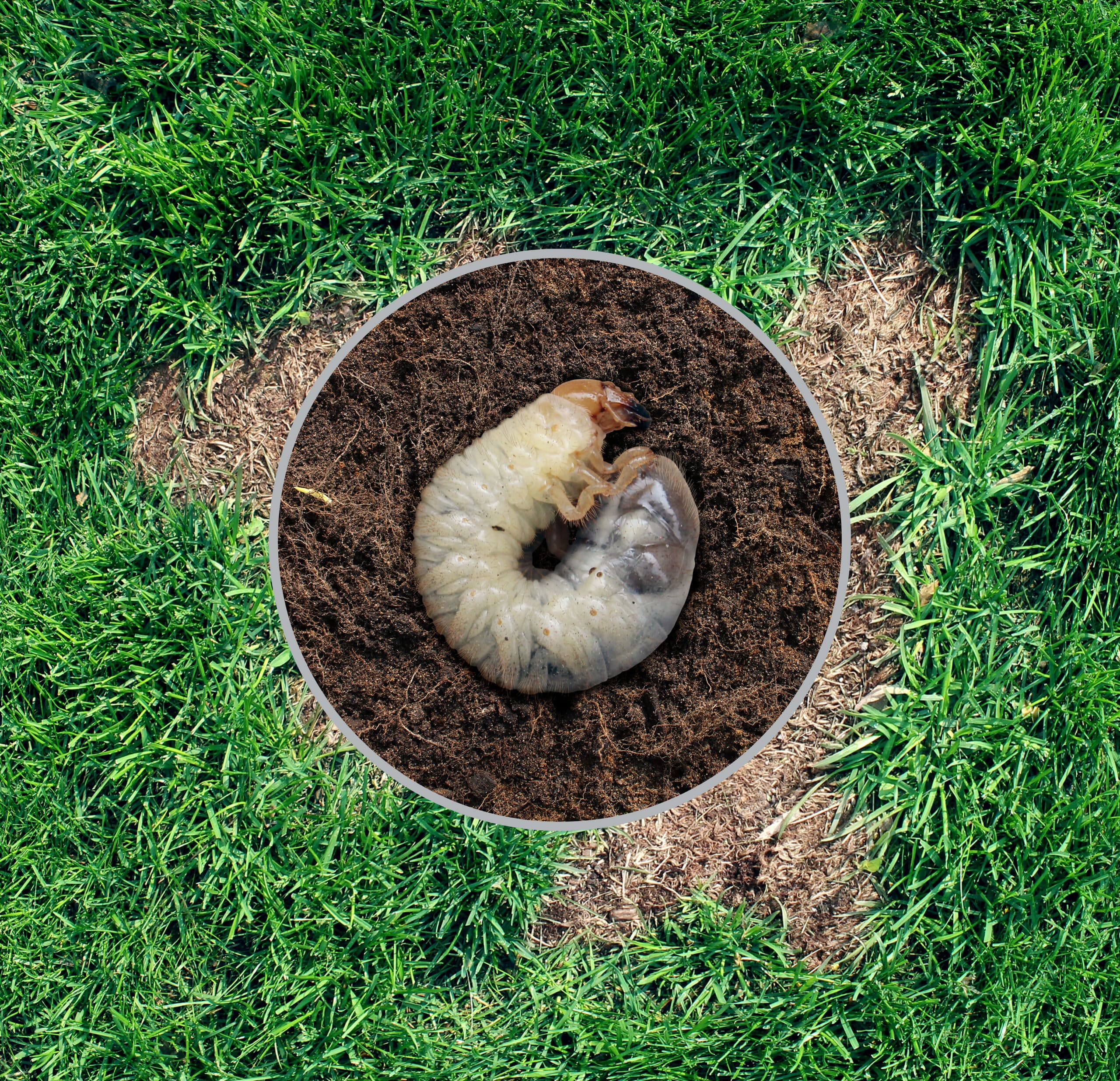Are raccoons and skunks digging up your lawn for a tasty meal? Is your lawn becoming brown?
We at Environmental Pest Management are experts in dealing with grubs in lawns. Learn how to identify a grub infestation and eliminate grubs in the lawn if you want to save your little haven from utter decay!
What Are Grubs in Lawn?
Known as lawn grubs or white grubs, grubs are pale white and squirmy larvae with brown heads. They’re about an inch long and curl into a C-shape when bothered. Larval is the immature form of various adult chafers and beetle species, including June bugs, European chafers, and Japanese beetles. You’ll find them emerging from underground in spring and early fall.
Lawn grubs are a natural part of the ecosystem, and healthy grass can support some grub feeding. But damage occurs when the population gets out of hand, as these pests feed on the roots of your grass, damaging your lawn.
Specifically, grubs feed on the thatch in lawns, an organic layer of dead and living shoots, roots, and stems. So they help manage lawn thatch, reduce its build-up, and, ironically, prevent pest problems.
The only issue is that they don’t stop at the thatch and feed on the turfgrass roots and crowns, killing your plants. Luckily, control methods will save your turf, so make sure you get the help of a pest control company like Environmental Pest Management. Professionals will inspect your lawn and consider your budget and safety when conducting their services in its infested areas.
How to Identify the Problem
Identifying the problem is the first step. It’s tricky because many pests cause the same lawn problems, so you should follow these two steps.
1. Look for the Signs

The signs of a grub infestation are:
- Patches of Thinning Turf: Do dead patches keep appearing and growing on your turf weekly?
- Yellowing Grass: This grass will eventually become a brown patch.
- Grass Pulling Out Easily: It may be unusually easy for you to pull out plants from their roots. As a result, more skunks, moles, raccoons, and crows start packing and digging in the lawn for food, leaving holes behind.
- Spongy Grass: The spongy texture of the grass makes for a soft underfoot and a bouncy step.
- Beetles and Moths: Infested areas invite beetles and moths to lay their eggs, so they’ll start flying over the turf.
- Grass Drought: You might notice signs of drought despite water availability.
2. Test Your Lawn
Now that you’ve seen the signs, you should confirm the existence of grub. Because they live underneath, you’ll have to do a little digging to see the pests. To conduct the following test:
- Locate the browning or dead patches.
- Use a shovel or lawn edger to dig up a hole, which should be one square foot large and two to three inches deep.
- Sift around the soil, looking for grub, and count them.
- Put back the grass you’ve cut out to avoid further damage.
- Repeat the steps in other patches that you suspect for grub infestations, and make a note of which areas have more grubs than others.
When you conduct this test, you’ll almost always find grub.
If they’re five or fewer, you have nothing to worry about. Five to ten grubs are only a concern if your lawn is unhealthy, as its ability to handle the grub feedings will be below normal. However, ten or more grubs is a sign of a serious infestation, and you must immediately implement pest control measures.
How to Treat Grubs on Lawn

Let’s go over how to chemically or naturally kill grubs in the lawn.
The Chemical Way
By far, the most effective control method is using chemical insecticides, which is necessary if you have a serious grub infestation.
So what do pest control services include? Well, you can expect professional exterminators to eliminate the existing infestation and prevent it from resurfacing, which is why they might use two types of insecticides.
Firstly, curative pesticides are short-lived chemicals (carbonyl and trichlorfon) that eliminate existing grubs immediately. They eliminate the active pests in your lawn but don’t affect future grubs. Curative pesticides are especially effective during August and September, as the grubs leave their eggs and are fragile. Otherwise, spring grips are more developed, putting up more resistance to the pesticide.
Request A Free No-Obligation Quote Today
We serve Dakota, Hennepin, Ramsey, Washington, and Anoka Counties.
We also serve Carver, Scott, Rice, Lesueur, and Steele
As for specific types of grubs, carbonyl is slightly more effective on European chafer grubs than trichlorfon. The two curative insecticides are great for getting rid of Japanese beetle grubs.
Secondly, experts use preventative insecticides to prevent future generations of grubs from infesting your lawn the next fall or spring, preferably ones containing thiamethoxam, imidacloprid, and clothianidin.
If they’re neonicotinoids, the grass absorbs the pesticides, killing grubs when they’re old enough to feed on the roots of the treated plants. Accordingly, they aren’t effective on grubs in lawns from mid-October to May.
When you find a grub infestation, you should use preventative insecticides for a year or two to prevent a reinfestation before stopping. However, don’t use these chemicals merely because the general area is known to have Japanese beetles or European chafers.
Remember that it’s better to let experts handle this because each preventative chemical has a slightly different application time, enabling it to target grubs when active. Not to mention, some products on the market are ineffective altogether, such as ones that contain only bifenthrin, gamma-cyhalothrin, lambda-cyhalothrin, cyfluthrin, deltamethrin, and permethrin.
The Natural Way
If you’re wondering how to get rid of grubs in the lawn naturally, we’ll cover some natural or organic treatments for these pests.
The first method is milky spores. These bacteria kill Japanese beetle grubs if the spring soil is warm enough. It’s safe for use; sprinkle the powder onto your turf to control the infestation.
The drawback is that it can be three years before you completely eliminate the grub population. Another complication that comes with using milky spores is that it works only on a specific species, so you must confirm that the grubs in your lawn are Japanese beetles via hand lens.
The second organic treatment for grubs uses beneficial nematodes. They’re microscopic parasitic worms that feed on and release enough bacteria to kill grubs off.
In terms of usage, you can apply nematodes in the afternoon. Start by watering the soil because these living organisms love moisture. Then, use the substance before watering again.
Note that nematode products should be used instantly after you purchase them. If not, the worms die and are unable to do the job.
Like milky spores, nematodes can get rid of grubs completely in up to three years. What makes them a long-term solution is that they reproduce, and their population feeds on grubs, among other pests, for several years.
How Dangerous Are Grubs?
If you’re tempted to let your grub infestation problem sort itself out, think again. Grubs live deep in the soil during winter and emerge in a few months, wreaking havoc on your plants and grass.
Aside from your lawn looking sad, the turf will get thinner, and the dead patches will increase gradually. It’ll become easy to pull out the damaged grass at its roots, and animals will start digging in for food. Moles will be attracted to your yard, especially if it has beetle grubs. These feedings are detrimental to the health of your grass and plants.
Final Words
Grubs are pale white larvae that live underneath the soil and feed on the grass thatch, roots, and crowns. They make your grass thin, yellow, and spongy, eventually killing it. You can take either the natural or chemical route to kill grubs in the lawn.
The natural one involves milky spores or nematodes, but it’ll be years before these treatments take full effect. As for the chemical route, pest management professionals use curative pesticides to kill active grubs and preventative pesticides to protect your grass against future grub infestations.
You have a serious infestation if you find ten or more grubs when digging a square foot hole in your lawn. So contact a pest control company like Environmental Pest Management. We, the experts, use safe control methods with little to no odor and only the best products to save your precious turf and lively plants.

